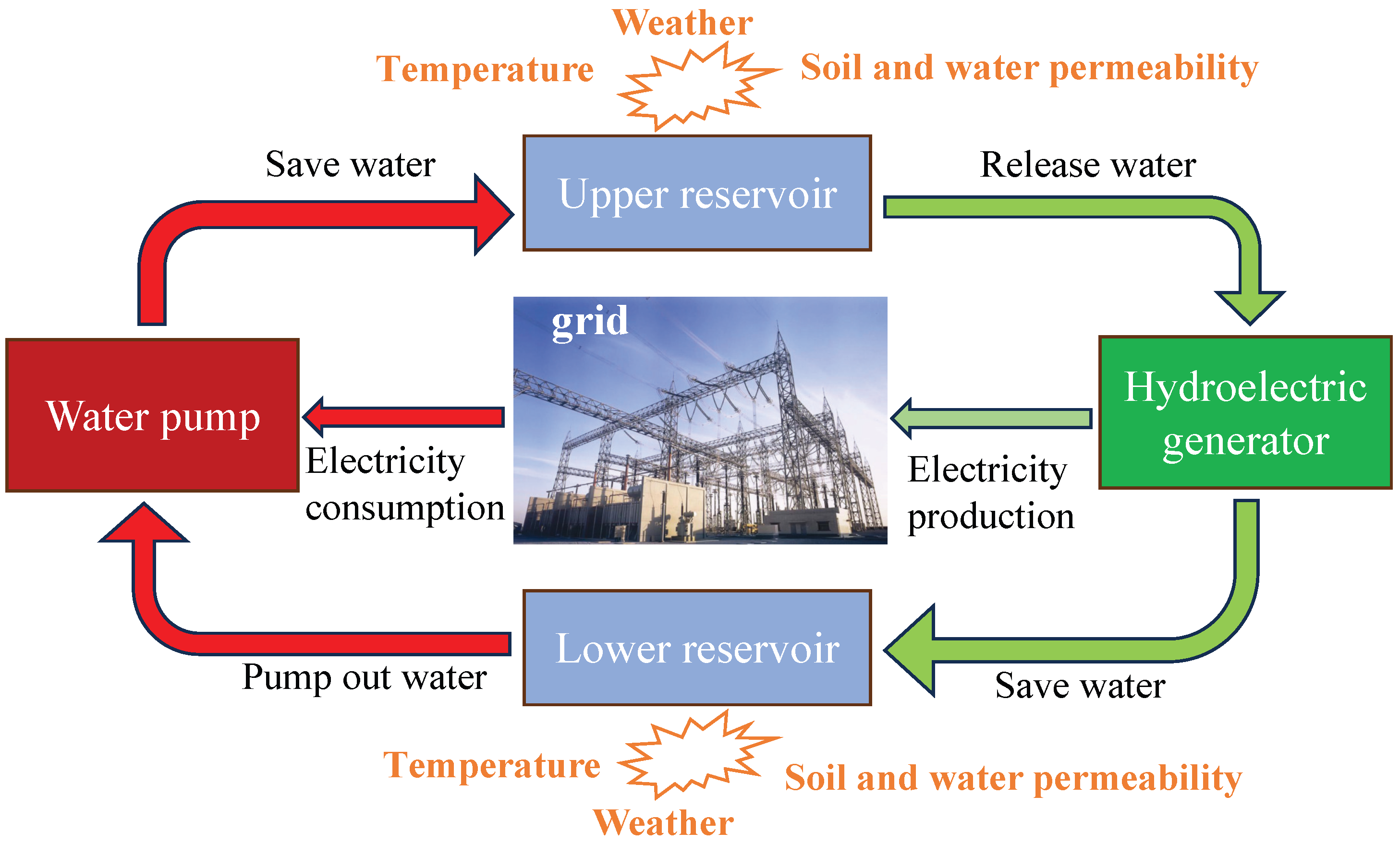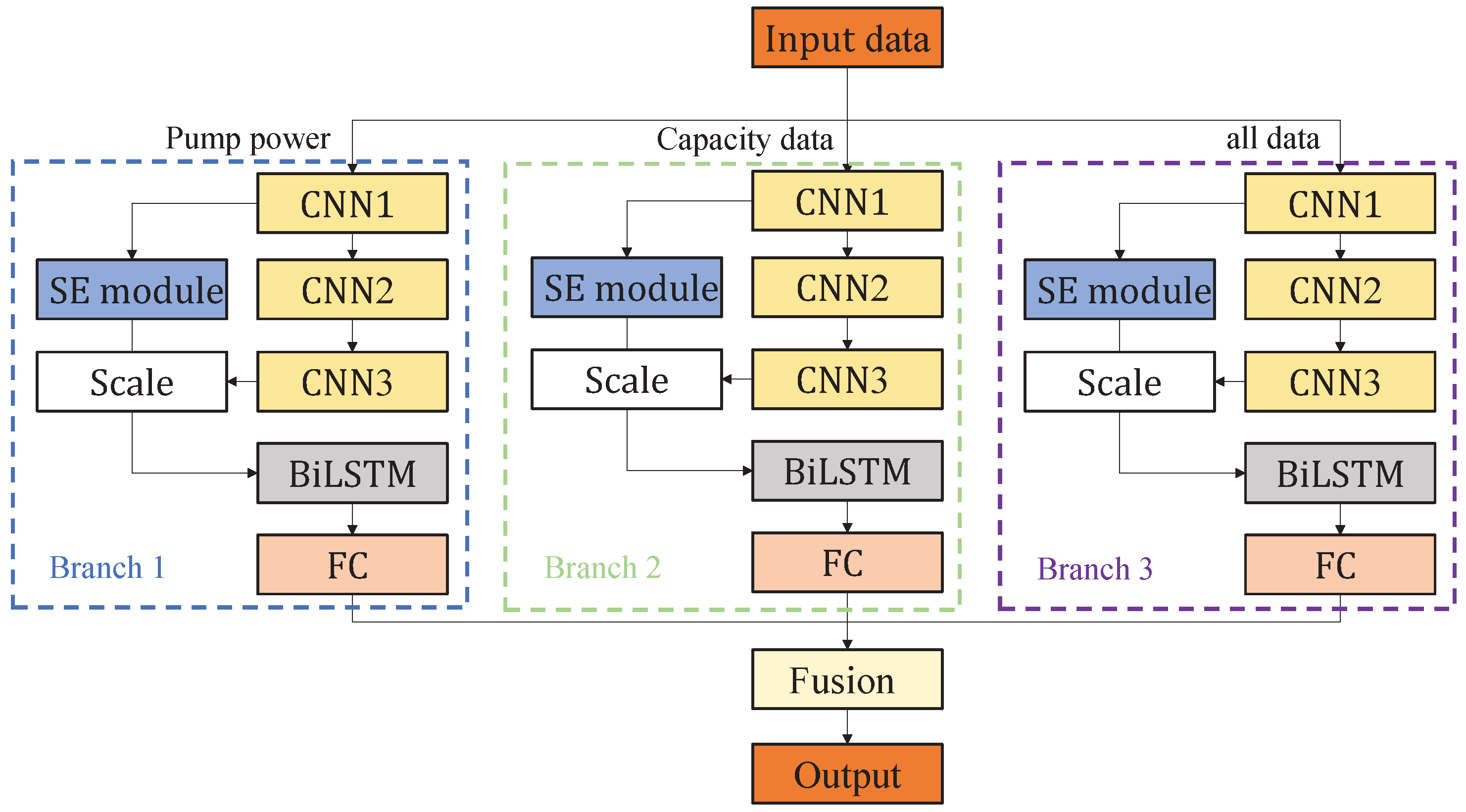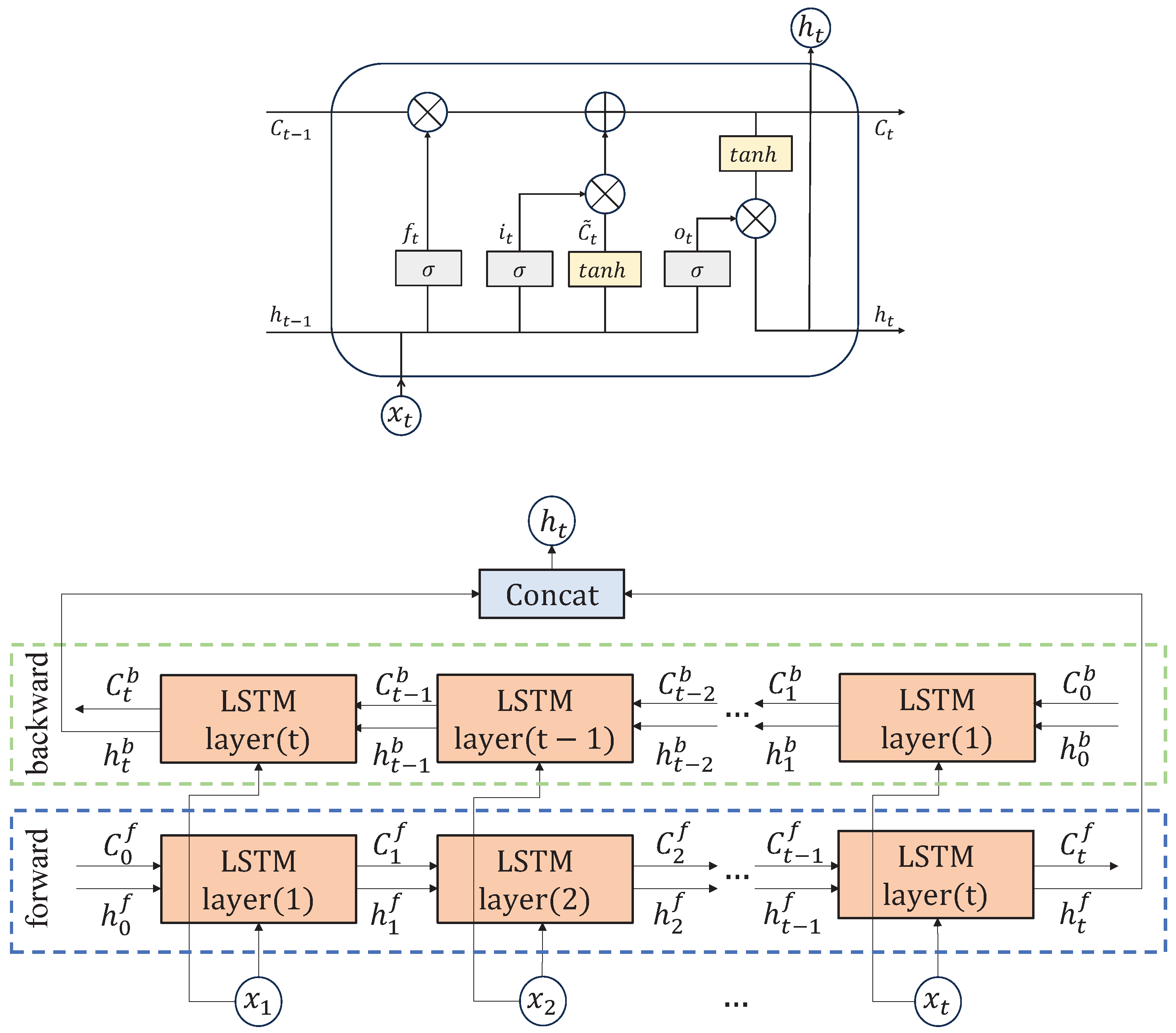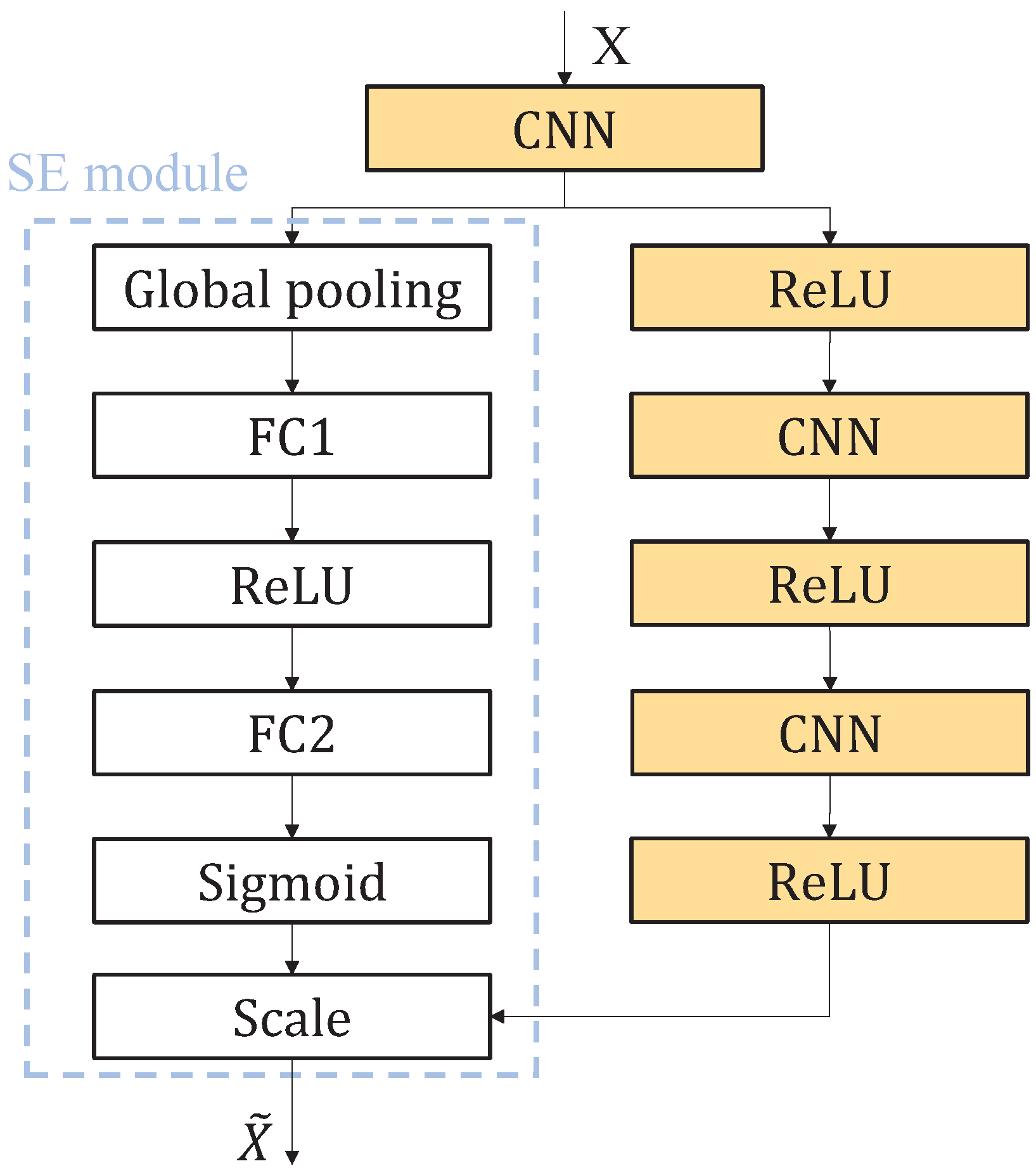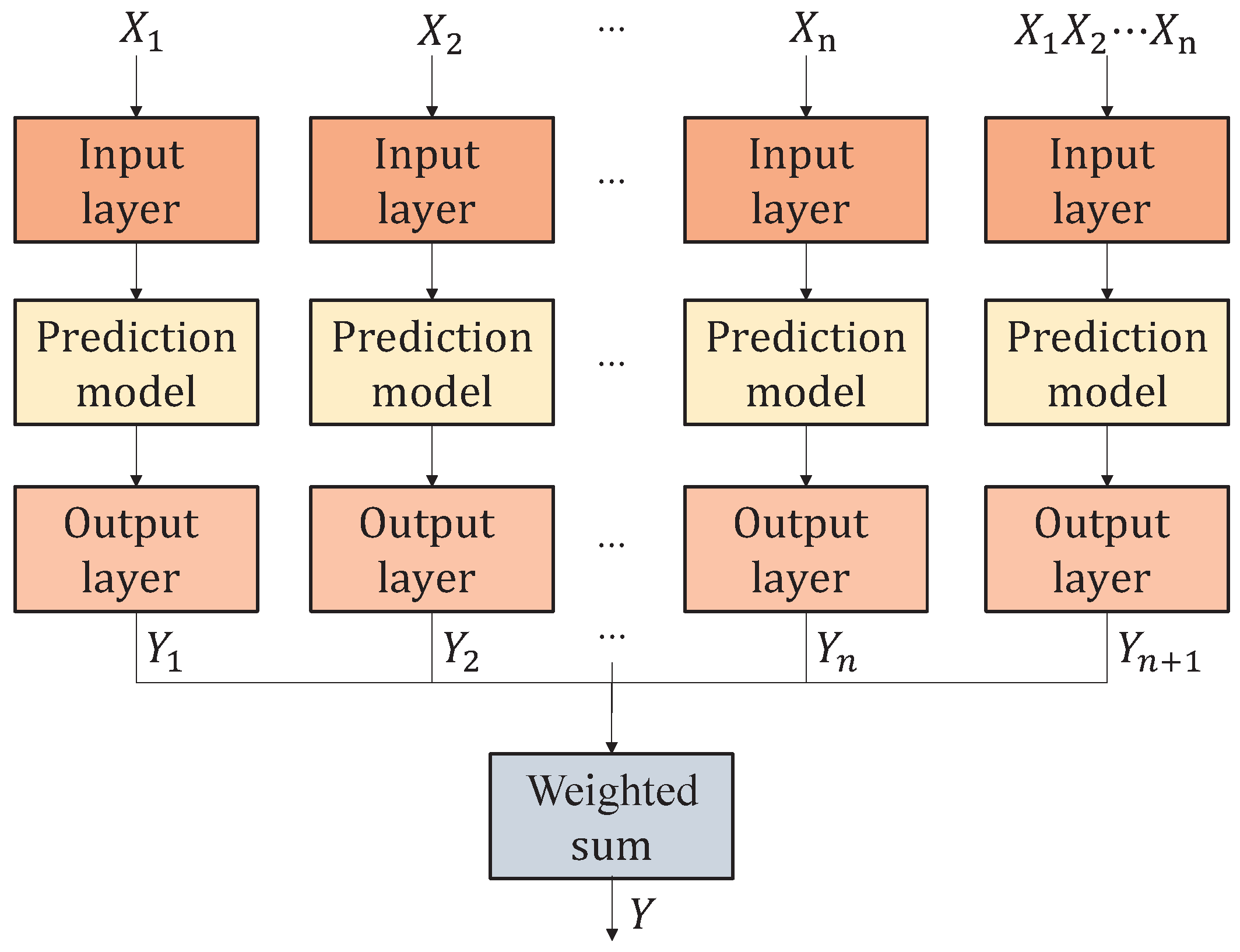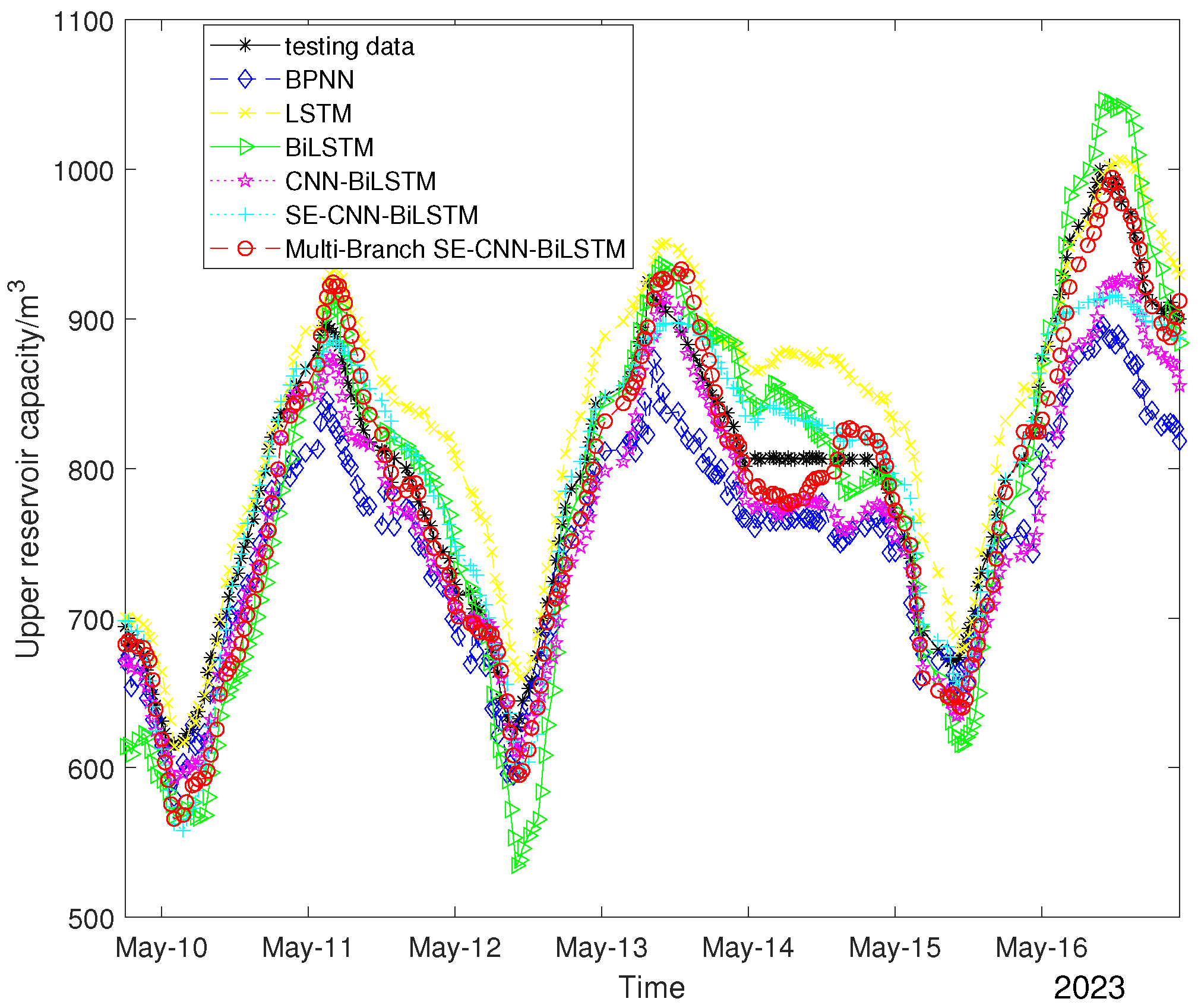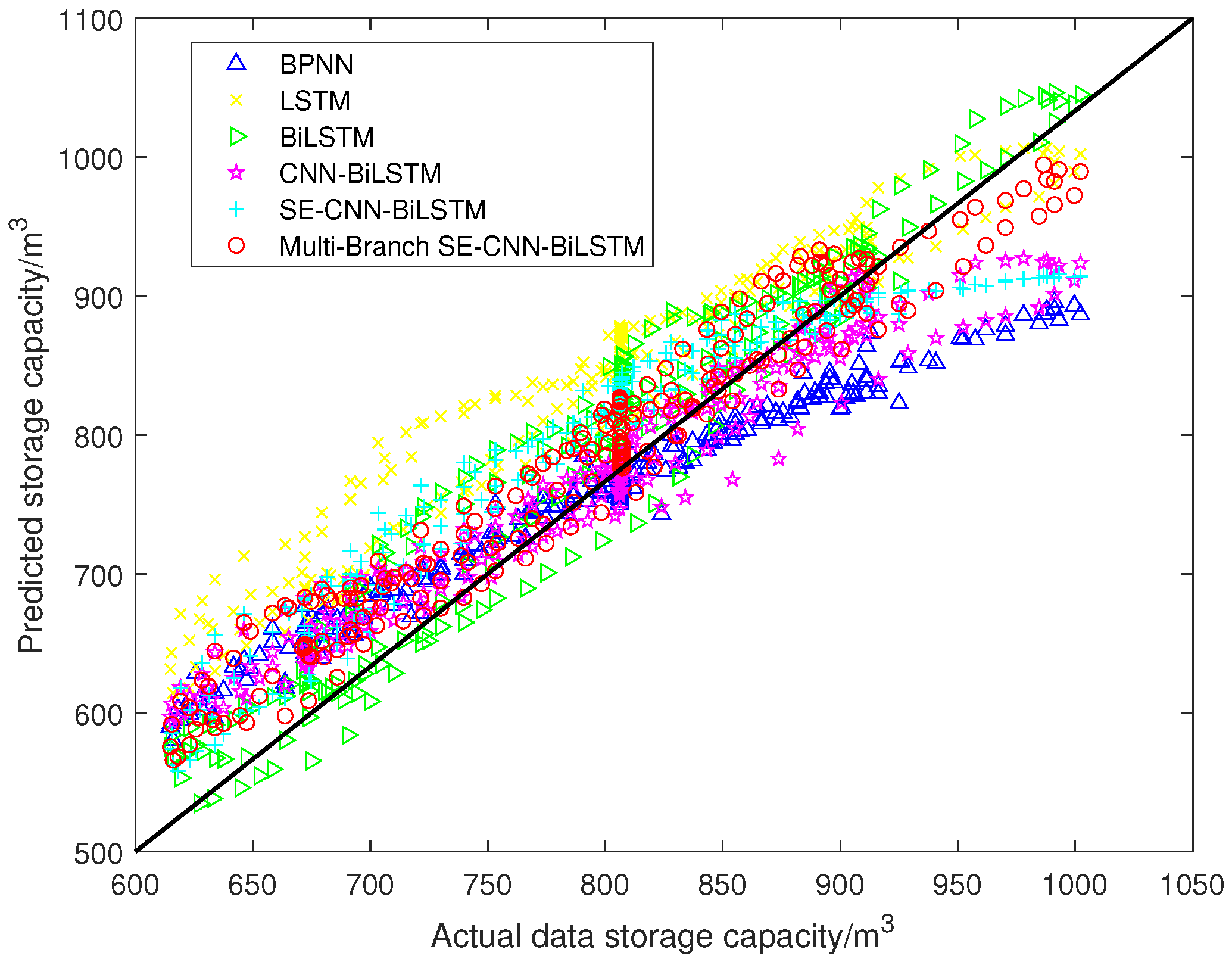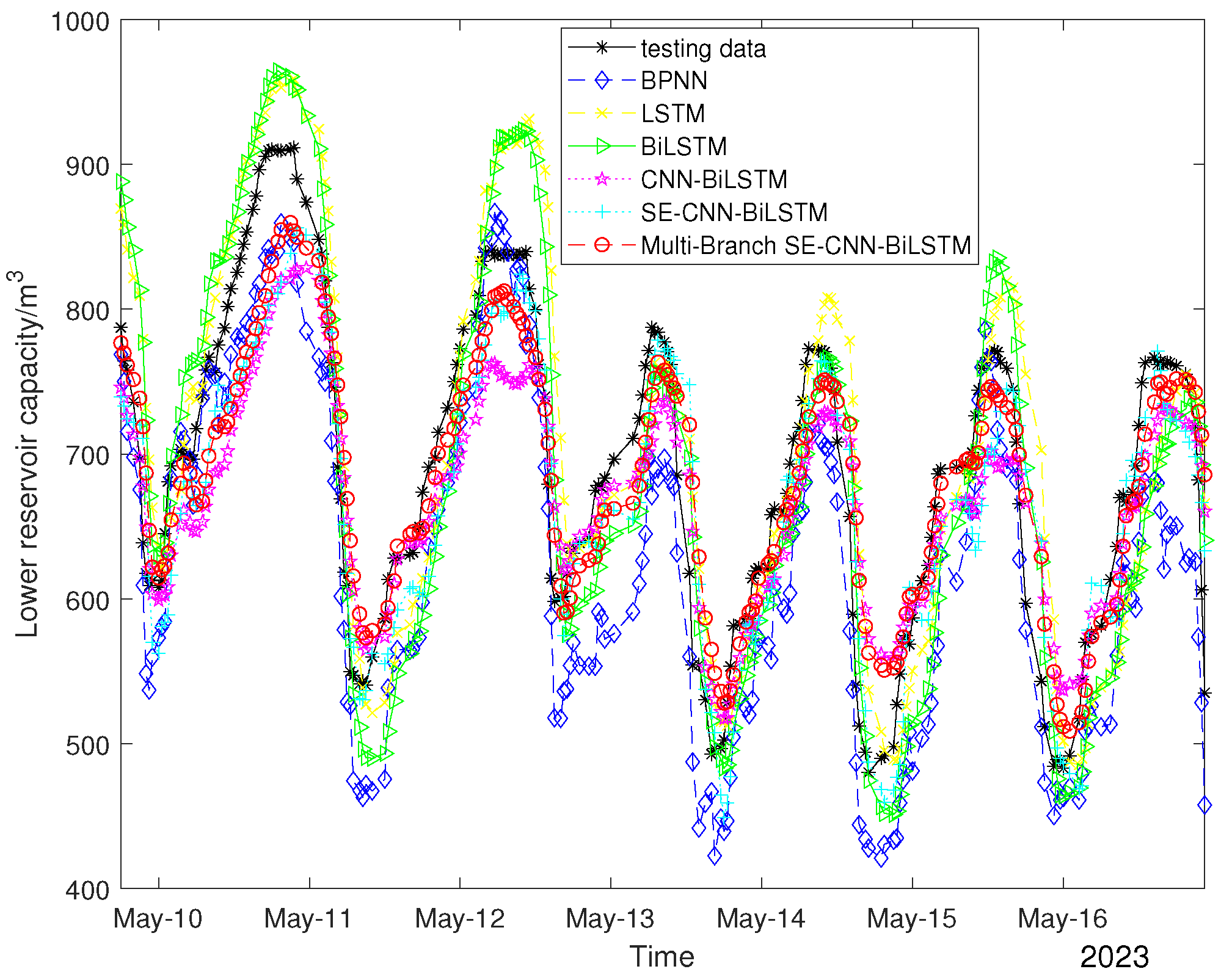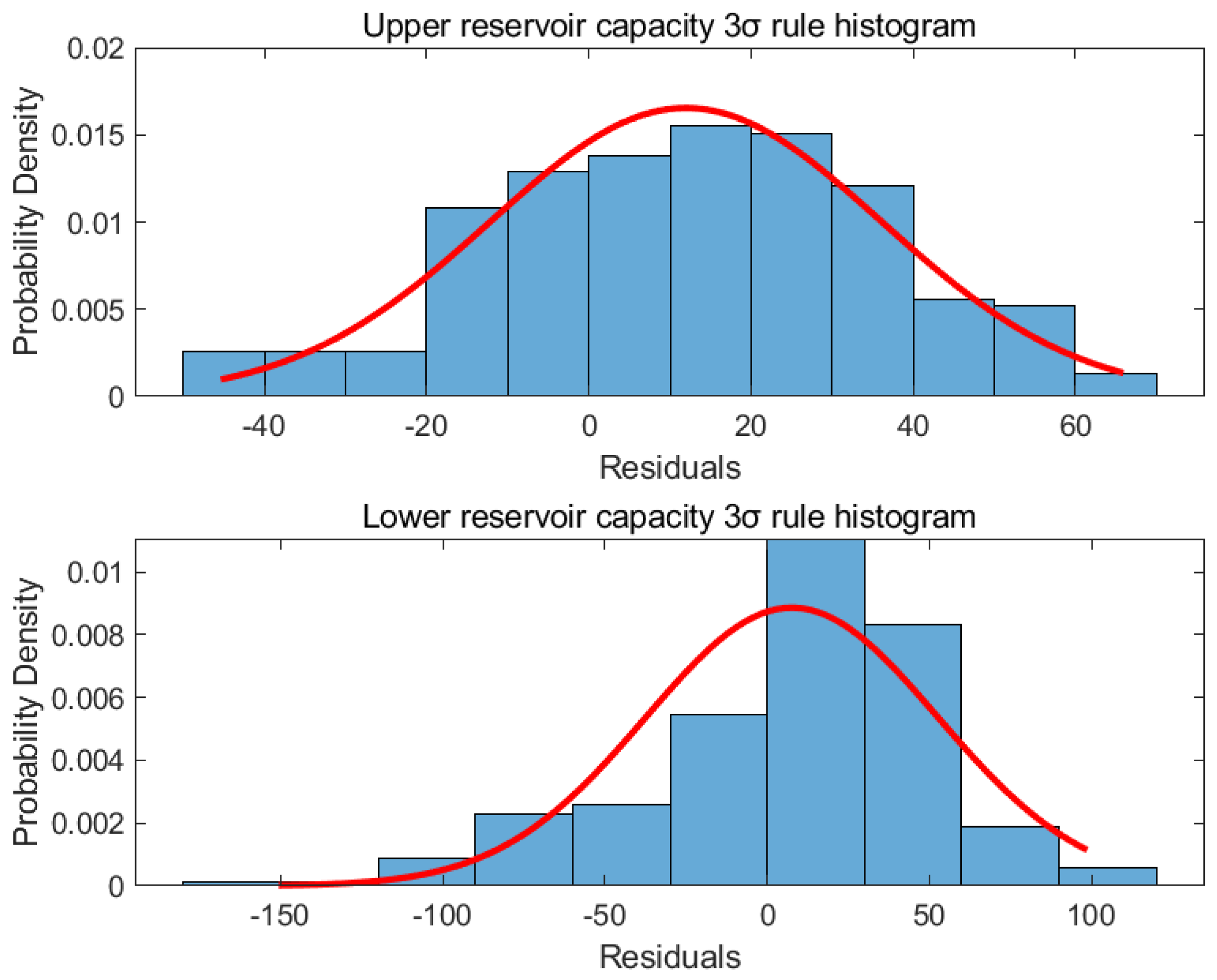1. Introduction
Among existing large-scale energy storage technologies, pumped storage power plants are the most attractive large-scale energy storage solution, due to the vast potential energy contained in their reservoirs, the high full-cycle energy conversion efficiency, the low unit cost of generation, and the flexibility they provide to transmission system operators in short-term operations [
1]. Pumped storage hydropower plants are important energy storage resources in the power system, which realize the recovery of electricity by mobilizing the water volume in reservoirs [
2,
3]. The main components of a pumped storage system include an upper reservoir (UR) and a lower reservoir (LR) for water storage, pressure pipes connecting the UR and LR, and pumps to lift water from the lower reservoir to the upper reservoir [
4]. Reservoir capacity is a core parameter of pumped storage hydropower plant operation, in which the upper reservoir is responsible for storing potential energy and the lower reservoir is used to collect the returning water. The capacity determines the energy storage capacity and operation efficiency of the pumping station [
5]. By using the electric power for pumping at the low point of electricity consumption, the water is stored in the upper reservoir, and releasing the water generates electricity at the peak point of electricity consumption. Pumped storage hydropower plants can provide the grid with functions such as peak shifting, valley filling, and emergency backup [
6]. A schematic of a pumped storage hydropower plant is shown in
Figure 1. The reservoir capacities are affected by many factors, including the released/saved water, weather, temperature, and soil and water permeability. Pumped storage accounts for approximately 96% of global stored electricity capacity and 99% of global stored energy [
7]. An accurate forecast of upper and lower reservoir capacity changes is important for realizing efficient scheduling and safe pumping station operation. The accurate forecasting of reservoir capacity can not only optimize the scheduling strategy of a pumping station but also reasonably allocate the water scheduling of the upper and lower reservoirs, improving the overall energy efficiency of pumping station operation. Therefore, the combination of advanced data-driven forecast methods can comprehensively explore the complex nonlinear relationship between multiple variables and provide a scientific basis for decision makers, which effectively guarantees the efficient and sustainable operation of pumped storage hydropower plants.
Data correlation analysis is a statistical method used to assess relationships between variables and is widely used in scientific research and practical decision-making [
2]. The correlation between input data and output data needs to be considered when making predictive models, and data with higher correlation can improve the predictive accuracy of the model. Common methods include the Pearson correlation coefficient [
8], Spearman correlation coefficient [
9], and Kendall correlation coefficient [
10]. The Pearson correlation coefficient is used to measure the linear relationship between two continuous variables and is suitable for data that are normally distributed and linear [
11]. The Spearman correlation coefficient and the Kendall correlation coefficient are based on the ordering of the data and are able to capture nonlinear but monotonic relationships and are suitable for the analysis of data that have a high number of outliers or are not normally distributed [
12]. The development of prediction models has experienced a gradual evolution from traditional statistical methods to modern deep learning models [
13]. Traditional mathematical models such as linear regression [
14], autoregressive (AR) analysis [
15], and the differential autoregressive moving average (ARMA) [
16] are widely used because of their simplicity and efficiency. However, these methods have limited ability to portray nonlinear features and complex relationships [
17]. Subsequently, Support Vector Regression (SVR) [
18] and Random Forest (RF) [
19], based on integrated learning and gradient-boosted decision trees [
20], have emerged, enhancing the ability of modeling nonlinear relationships but performing slightly less well in capturing time dependencies.
With the development of neural networks, such as back-propagation neural networks (BPNNs) [
21] and artificial neural networks (ANNs) [
22], the ability of models to recognize complex nonlinear features is further improved [
23]. In particular, deep learning models such as convolutional neural networks (CNNs) [
24,
25,
26,
27] and long short-term memory (LSTM) networks [
28,
29] have gradually become mainstream, with CNNs being able to efficiently extract local features and LSTM being effective at capturing long-term and short-term temporal dependencies. LSTM effectively solves the problem of gradient vanishing in traditional recurrent neural networks (RNNs) in long sequence learning through its gating mechanism, while bidirectional LSTM (BiLSTM) further develops this structure to capture richer contextual information in the time series by simultaneously processing the sequence data in both the forward and backward directions [
30], thus improving the comprehensiveness and accuracy of prediction [
31]. In order to obtain more accurate prediction models, hybrid models combining CNNs with LSTM or BiLSTM are widely used, which significantly improve the prediction accuracy by integrating the advantages of CNNs and LSTM [
32]. The pattern of partial discharge for overhead covered conductors is detected by combing LSTM and GRUs together [
33].
To further enhance the model’s ability to focus on key features, researchers introduced an attention mechanism to dynamically adjust the feature channel weights in a prediction model. The attention mechanism was implemented mainly by assigning weights to map the importance of different parts of the input to a weight vector [
34]. The common methods for computing attention are mainly dot product attention and additive attention [
35]. These methods obtain the weights associated with the input by performing appropriate transformations and similarity calculations on the input features. The Squeeze-and-Excitation (SE) attention mechanism is widely used in CNNs. In recent years, the multi-branch network structure has also received increasing focus [
36]. This structure is able to extract the feature representation of each type of information in a targeted way by introducing multiple independent branch networks to specialize different input features.
In order to better manage the scheduling of upper and lower reservoir capacities in pumping stations, this paper establishes a Multi-Branch Attention–CNN–BiLSTM forecast model for predicting upper and lower reservoir capacities at future moments. Specifically, BiLSTM is used as the baseline forecast model, and a CNN is introduced to extract local features from raw time series data to capture short-term dependencies. An SE attention mechanism is used to adaptively adjust the weights of the forecast network. In order to further analyze the relationship between the data, the correlation between the input data and the output data is analyzed by using Spearman’s eigenfactors. A three-branch structure is set up and the branch forecast results are weighted to obtain the final forecast results, forming the Multi-Branch Attention–CNN–BiLSTM network. The main contributions of this paper can be summarized as follows:
- (1)
An improved Multi-Branch Attention–CNN–BiLSTM network is proposed for reservoir capacity forecasting to improve feature extraction ability and enhance accuracy. A weighted fusion module is proposed to fuse the forecasting results. The proposed Multi-Branch Attention–CNN–BiLSTM framework can better capture nonlinear and non-stationary features of the data samples.
- (2)
Spearman’s coefficient is presented to analyze the input–output data relationship to optimize feature selection and focus on the most relevant features. SE is designed to adaptively adjust the weights of the network, thereby enhancing the model’s ability to focus on the most relevant features for more accurate forecast.
- (3)
A real application validation in a hydropower generation station shows that the proposed model can enhance model robustness and improve accuracy for reservoir capacity forecasting.
The outline of this work is given as follows. Data Descriptions and Pre-Processing is given in
Section 2 with details of data descriptions and pre-processing. The Multi-Branch Attention–CNN–BiLSTM model is presented for reservoir capacity forecasting in
Section 3. In
Section 4, experimental results and analysis are given to show the effectiveness of the proposed method.
Section 5 concludes this work.
3. Multi-Branch Attention–CNN–BiLSTM Design for Upper and Lower Reservoir Capacity Forecasting
In this paper, a Multi-Branch Attention–CNN–BiLSTM network is designed for upper and lower reservoir capacity forecasting. The model takes BiLSTM as the baseline forecast model and introduces the CNN to improve the feature extraction ability of the model on the time series, which helps the model to better handle the depth information of the time series. To further improve the model’s ability to pay attention to data processing, the CNN is tuned by using the SE attention mechanism. The data used in this paper include reservoir capacities, water levels, and pumping machine power, and different data have different correlations for reservoir capacities.
In order to better extract the relationship between different data and reservoir capacity, this paper adopted a multi-branch network model, and each branch adopts the same Attention–CNN–BiLSTM structure. The branches were fed with different data types, respectively, and one of the branches included all data types. Each branch obtained the forecast values of the reservoir capacities, and finally all the forecast values were fused together by the weighted sum to obtain the final forecast results. The structural framework of the Mulit-Branch Attention–CNN–BiLSTM forecast model is shown in
Figure 3.
A three-branch structure was designed with one input for pump power, one input for reservoir capacity and level, and one input for all data. The weighted sum of the fusion modules uses the following formula:
where
,
, and
are the forecast outputs of the first, second, and third branches, respectively;
,
, and
are the weights of the first, second, and third branches, respectively; and
. The corresponding weights were calculated based on the correlation coefficients in
Table 2. The specific steps were calculating the average of the correlation coefficients of each channel and then calculating the weights based on the proportion of the three average correlation coefficients. The expression for weight calculation is
where
is the weight of the
ith channel;
is the average correlation coefficient of the
ith channel; and
are the average correlation coefficients of the three channels. In this paper, we used Spearman’s characteristic coefficient analysis and finally set
;
; and
.
3.1. Bidirectional Long- and Short-Term Memory Network
LSTM is a special RNN designed to solve the long-term dependency problem in sequence data. Although traditional RNNs are capable of handling sequence data, they perform poorly when dealing with long sequences due to the gradient vanishing or explosion problem. LSTM is able to alleviate this problem by introducing a gating mechanism which can effectively selectively remember or forget information. In addition, LSTM adds the cell state number
C as a memory unit to correlate information over a longer time span. The core of LSTM consists of the forget gate, input gate, output gate, and cell state. The structural framework of the LSTM layer is shown in
Figure 4.
- (1)
Forget gate: The forget gate is used to control which historical information needs to be forgotten. A weight between 0 and 1 is generated for adjusting the forgetting ratio by weighting and summing the hidden state of the previous time step
and the current input
as well as activating it. The expression for the equation of the forget gate is given:
where
is the weight;
is the bias; and
is the Sigmoid function. The expression for the equation of the Sigmoid function is given as follows:
- (2)
Input gate: The input gate determines which parts of the information from the current time step need to be added to the cell state and regulates the strength of the information update by an activation function that combines the current input and the previous hidden state. The expressions for the equations of the input gate are given as follows:
where
and
are weights;
and
are biases; and tanh is the Tanh function. The expression for the equation of the Tanh function is
- (3)
Output gate: The output layer is used to regulate and output the hidden state output from the LSTM in the current time step, which contains extensive time-dependent information and is adapted to the current time step. The expression for the equations of the output gate are
where
is the weight;
is the bias; and
is the current cell state number.
- (4)
Cell state: The cell state is an important carrier of LSTM memory, which keeps the long-term memory of sequence data by discarding part of the old information through the forget gate and then introducing new information in combination with the input gate. The expression for the equation of the cell state is
The structure of LSTM can only process sequence data from front to back sequentially, which may ignore the effect of future time steps on current time steps. In many practical applications, however, future information often plays an important role in current judgment as well. For this reason, scholars have researched BiLSTM. BiLSTM processes sequence data from two directions by using two independent LSTM layers in both forward and backward directions. Forward LSTM extracts forward-dependent features of the time step from the sequence start point to the end point; backward LSTM extracts backward-dependent features of the time step from the sequence end point to the start point. The features in these two directions are eventually weighted and merged to generate a complete contextual representation of each time step, thus improving the model’s ability to understand the sequence data. The structural framework of BiLSTM is shown in
Figure 4. Both forward and backward LSTMs learn the input data to obtain their respective hidden states with long-term dependence. BiLSTM connects the two hidden states, allowing the model to understand the time-series data in a more comprehensive way, which is suitable for complex forecast tasks.
3.2. Convolutional Neural Network and SE Attention Mechanism Design
In the regression forecast for reservoir capacities, the CNN can efficiently extract local patterns in time series data and reduce noise interference and provide high-quality feature representations for the subsequent forecast process. The CNN is mainly responsible for extracting local patterns and key features in the input data in CNN-BiLSTM-based regression forecasting, which provides more effective feature representation for subsequent time-dependent modeling. The CNN extracts local feature patterns from the input data through convolutional layers, such as short-term trends and key changes in the time series, and significantly reduces the computational complexity of the network by utilizing parameter sharing and local connectivity. The superposition of multiple convolutional layers enables the model to progressively extract more abstract features from low to high levels. In order to capture nonlinear relationships, the output after convolution is usually nonlinearly mapped by an activation function (e.g., ReLU), which provides the model with stronger expressive capability. To better extract the feature relationship between the data, this paper uses the connection of three convolutional layers, and the convolutional layers are connected by the ReLU activation function.
In traditional neural networks, the model processes the input data uniformly and does not differentiate between the attention paid to different parts. However, when processing longer time series, some parts may be more important than others. The purpose of the attention mechanism is to enable the model to selectively focus on the interested or critical parts of the data sequence, enabling further improvements in model accuracy. In this paper, we use the SE attention mechanism to improve the CNN network to help the model accurately capture key features and effectively reduce the interference of irrelevant information in the model. The SE attention mechanism is a lightweight but efficient channel attention mechanism that focuses on improving the feature representation of the CNN. Traditional CNNs assign the same importance to all channels by default when processing features, but in real tasks the contribution of different channels to the final goal often has differences.The SE attention mechanism improves the performance of the model by dynamically adjusting the weights of each channel to emphasize the important feature channels, while suppressing irrelevant or redundant channel information. The SE module consists of three parts: global information embedding (Squeeze), adaptive recalibration (Excitation), and reweighting (Scale). The structure of SE attention in the CNN is shown in
Figure 5.
In the SE attention mechanism, the number of channels in the previous fully connected layer (FC) is 1/8 of the number of channels in the latter FC; the number of channels in the latter FC is equal to the number of channels in the last CNN layer. In the Squeeze stage, the SE module compresses the spatial information of each channel through global average pooling, generates the global feature description and extracts the key channel correlations; in the Excitation stage, the dependencies between channels are learned through a series of fully connected layers and activation functions, and the weighting coefficients are generated. In the Scale stage, the weights obtained earlier are reused on the original feature map to realize the dynamic adjustment of the channel features, thus improving the expressive ability of the model.
3.3. Multi-Branch Network for Attention–CNN–BiLSTM
To fully exploit the role of multi-source information in the forecast task, the multi-branch network structure has been widely adopted in SE Attention–CNN–BiLSTM forecast networks. By building a branch network to receive different categories of factors related to the target variable separately, a comprehensive input branch is introduced at the same time which is used to capture the global pattern of the overall features. The branch network structure is shown in
Figure 6.
The structure of each branch of a multi-branch network is kept consistent by extracting feature representations of different inputs and fusing them in subsequent layers. Weighted fusion, an attention mechanism, or feature splicing are usually adopted in the fusion stage to ensure that the importance of different sources of information in decision making is reasonably expressed. Compared with the traditional single structure, models based on multi-branch design can more effectively separate and utilize relevant information from multi-source data, while demonstrating significant performance advantages in scenarios with complex data features or diverse sources. This structure provides a general and efficient solution for reservoir capacity forecasting.
4. Experiment Results
In this paper, Multi-Branch Attention–CNN–BiLSTM was used to predict the capacity of the upper and lower reservoirs. The input data included the power of U01, the power of U03, and the water level and capacity of the upper and lower reservoirs in the last five steps, each with a time interval of 30 min. The output data were the upper and lower reservoir capacities in the next step. The dimension of input data was 40 and the dimension of output data was 2. The training data were converted to 6473 rows and the test data were 341 rows according to the model data requirements. Multi-Branch Attention–CNN–BiLSTM was trained using the training data and the model was tested by using the test data. The model was validated by using metrics such as the , the , and , as well as scatter plots and distribution plots, to ensure correct forecasting of the model.
4.1. Model Training
In order to conduct the model training, this paper set appropriate Multi-Branch Attention–CNN–BiLSTM model parameters. The Multi-Branch Attention–CNN–BiLSTM model parameters are shown in
Table 3. To balance the capability of the model and the computational complexity, 32 BiLSTM hidden-layer neurons were set in this paper. The number of channels of the CNN layer was set to 64 channel counts for the first layer and 32 for both the second and the third layers, which helped the model to extract multi-layered features from the original data and reduced the computational complexity and the risk of overfitting. To ensure the reliability of the weighted sums of the different branches, this paper scaled the division based on the correlation between the input data and the output data. The correlations of the input data of the three branches were averaged and the three averages were converted to a value whose sum was equal to one. The final weighted ratios were
;
; and
.
4.2. Model Testing
In this paper, the
, the
, and
were used to statistically forecast the accuracy of the model. The
is the mean absolute percentage error, which does not change due to global scaling of the variables.
is the root mean square error, which measures the deviation of forecast values from actual observations.
is the coefficient of determination, which is a visual representation of the accuracy of the model and can take values between 0 and 1. The smaller the values of the
and
are, the higher the forecast accuracy of the model is; the closer
is to 1, the higher the forecast accuracy of the model is; and the closer
is to 0, the worse the forecast accuracy is. The expressions of the
, the
, and
are
where
is the forecast value;
is the actual value;
is the average value; and
n is the size of the data.
To verify the effectiveness of Multi-Branch Attention–CNN–BiLSTM in this work, multiple models were used for comparison including the original LSTM model, the original BiLSTM model, CNN-improved BiLSTM (CNN-BiLSTM), and SE attention mechanism-improved CNN-BiLSTM (SE-CNN-BiLSTM). In addition, in order to verify that the LSTM family of models has a better forecast ability for time series data, the BPNN model was introduced for comparison. The forecasts of the upper reservoir, lower reservoir, and average capacities in different models are respectively shown in the
Table 4,
Table 5, and
Table 6. The distribution and scatter plots of the forecast values of different models on the test data are plotted. The distribution and scatter plots of the upper reservoir capacity forecast results are shown in
Figure 7 and
Figure 8. The distribution and scatter plots of the lower reservoir capacity forecast results are shown in
Figure 9 and
Figure 10.
As can be seen from
Figure 7,
Figure 8,
Figure 9 and
Figure 10, the Multi-Branch SE–CNN–BiLSTM designed in this paper had the best results in the double-output forecast of the upper and lower reservoirs, and our model could complete the forecast of the upper and lower reservoir capacities. This is not only reflected in its ability to follow the trend of the actual data but also in the alignment of the predicted values with the actual values in the scatter distribution plots. In
Figure 7 and
Figure 9, the predicted curves of the Multi-Branch SE–CNN–BiLSTM model are closest to the actual data curves, indicating that the model was able to effectively capture the dynamic changes in the data. In
Figure 8 and
Figure 10, the point-to-point distributions of predicted and actual values are closest to the diagonal line, which further validates the high accuracy of the Multi-Branch SE–CNN–BiLSTM model model predictions. Both LSTM and BiLSTM achieved better forecast results compared to the BPNN, which indicates that the BPNN is not ideal for performing time series processing. From the tab4,tab5,tab6, it can be seen that Multi-Branch SE–CNN–BiLSTM predicted the upper reservoir capacity with an
of 0.9231,
of 2.8853%, and
of 26.8869
; and it predicted the lower reservoir capacity with an
of 0.8242,
of 5.4251%, and
of 45.5623
. The average metrics for the two reservoir capacities were an
of 0.8737,
of 4.1552%, and
of 36.2246
. The computing time of Multi-Branch Attention–CNN–BiLSTM was only 0.0525 s, which is very short time for the considered problem, although it required more computing time compared to other models. This is due to the fact that Multi-Branch Attention–CNN–BiLSTM has a more complex model architecture.
The introduction of the CNN and SE attention mechanisms substantially improves the forecast accuracy of the model. The upper and lower reservoir capacity of CNN-BiLSTM was improved by 0.9316% and 0.8452% compared to that of BiLSTM, respectively, and the mean of the two was improved by 0.8884%; the upper and lower reservoir capacity of SE-CNN-BiLSTM was improved by 1.0209% and 0.9396% compared to that of CNN-BiLSTM, and the mean of both was improved by 0.9802%. The introduction of the multi-branch model improved the forecast accuracy of the lower reservoir capacity and further ensured the accuracy of the double-output model forecast. The introduction of the multi-branch model made the model forecast values more closely match the distribution of the actual data, which indicates the reliability of multi-branch improvement in the double-output forecast of the upper and lower reservoirs.
The 3 rule is used to assess the reliability of the forecast of a predictive model. In statistics, data are normally distributed in principle, and the percentage of values that are less than one standard deviation, two standard deviations, and within three standard deviations from the mean are the precise figures of 68.27%, 95.45%, and 99.73%. Therefore, it can be assumed that a data value is almost distributed within the interval , and the probability of exceeding this range is less than 0.3%. After the forecast model generates results, the mean and standard deviation of the distribution of forecast values can be calculated as a way of determining whether certain forecast values are outside a reasonable range. When the forecast result exceeds three times the standard deviation, it indicates that there is an error in the model or an anomaly in the forecast target data. By analyzing these anomalous results, it can be found to provide a warning for the forecast target to avoid loopholes or equipment problems in the daily production process.
In this paper, the difference between the actual and forecast data was calculated separately for the upper and lower reservoir capacities, and the 3
ReLu historgram of the difference was analyzed. The mean value of the upper reservoir capacity residual was 11.9863
and the standard deviation was 24.1193
; the mean value of the lower reservoir capacity residual was 7.6263
and the standard deviation was 45.0166
. The 3
ReLu historgram of the error of the upper and lower reservoir capacity is shown in
Figure 11. Therefore, the error distribution of the upper reservoir capacity is
, and the range of error distribution for the lower reservoir capacity is
. When the residuals exceed these ranges, there may be a problem with the upper and lower reservoir capacities, such as leakage. This information allows workers to provide real-time maintenance to ensure the safe operation of a pumped storage hydropower plant.
5. Conclusions
In this paper, the Multi-Branch Attention–CNN–BiLSTM forecast model was developed to predict the upper and lower reservoir capacities of pumped storage hydropower plants. The correlation of the data was analyzed using Spearman’s characteristic coefficients, and the power of , the power of , and the level and the capacity of the upper and lower reservoirs were selected to predict the capacity of the upper reservoir. The experimental results show that the Multi-Branch Attention–CNN–BiLSTM model exhibits higher accuracy in predicting the reservoir capacity of pumped storage hydropower plants compared to the baseline model. Compared with the original BiLSTM, the forecast results were closest to the trend of the test data, with an increase of and in the , and in the , and and in , respectively. Using the Multi-Branch Attention–CNN–BiLSTM model, the average metrics for the two reservoir capacities were an of 0.8737, of 4.1552%, and of 36.2246 . The error distribution ranges of the upper and lower reservoir capacities were obtained based on 3 as and , respectively, and such information can provide a real-time maintenance strategy to ensure the safe operation of pumped storage hydropower plants. The prediction model proposed in this paper has dual outputs, and the change in the lower reservoir capacity is more unstable than the change in the upper reservoir capacity, which leads to a larger error range in the lower reservoir capacity.
